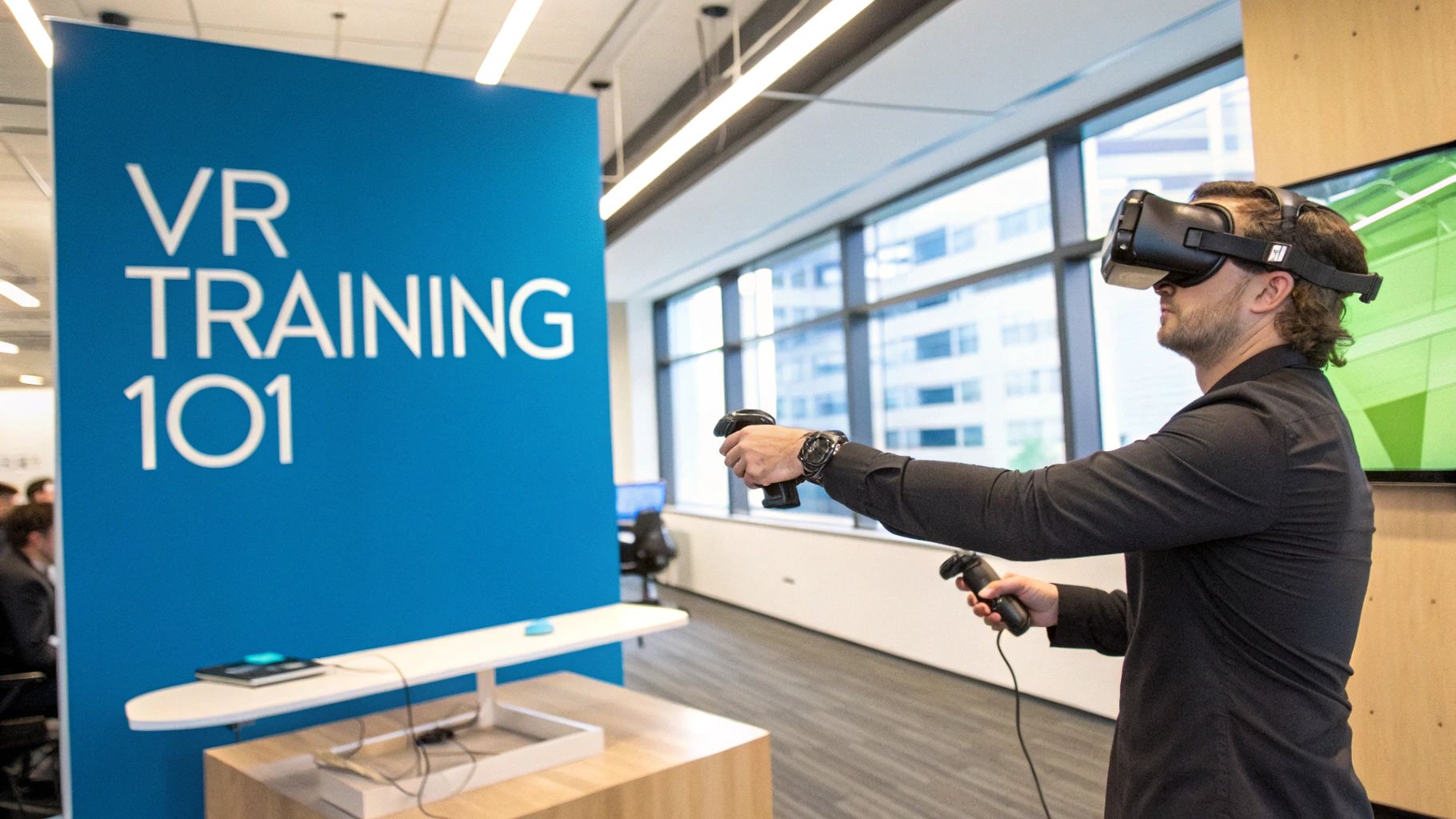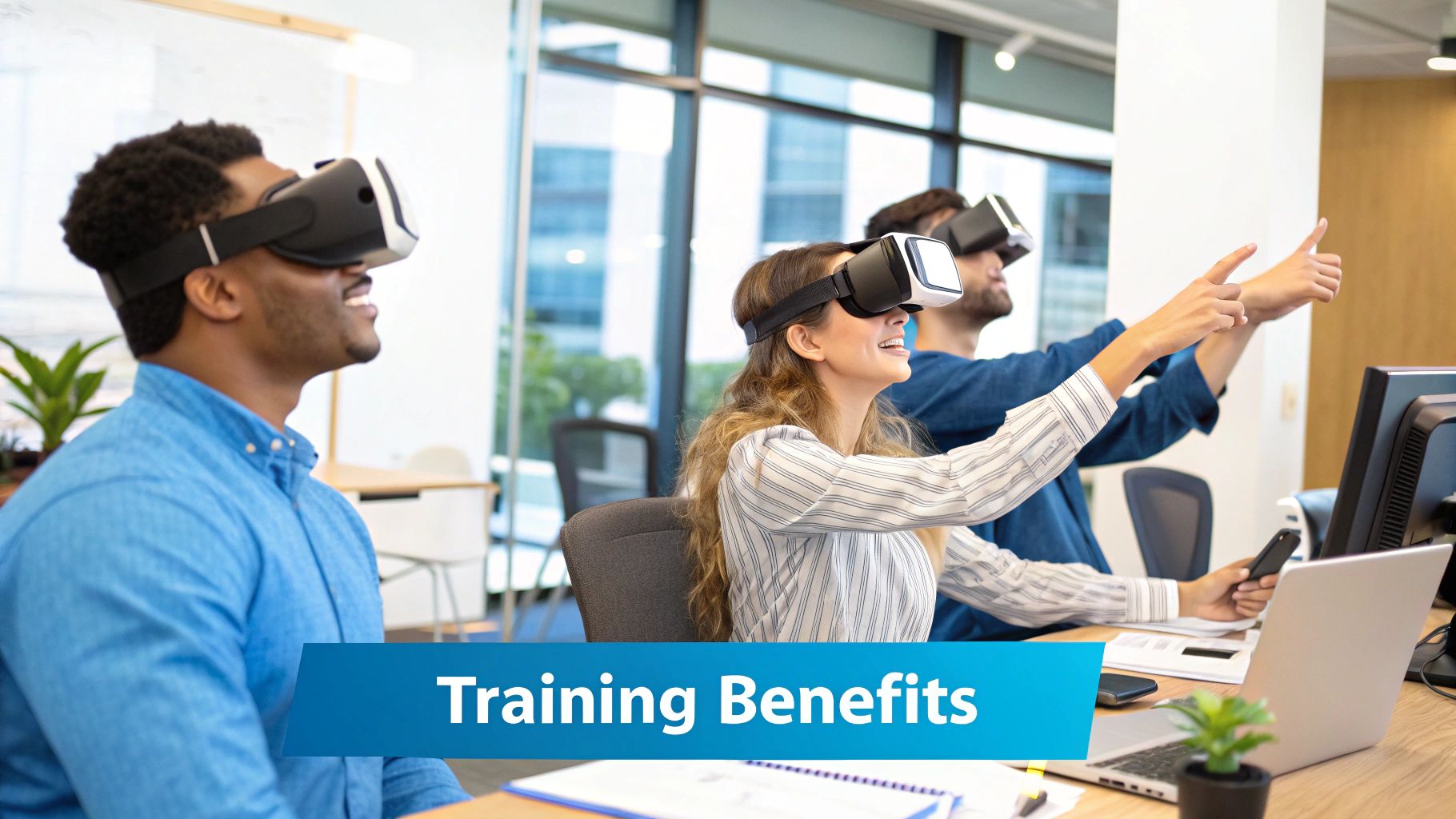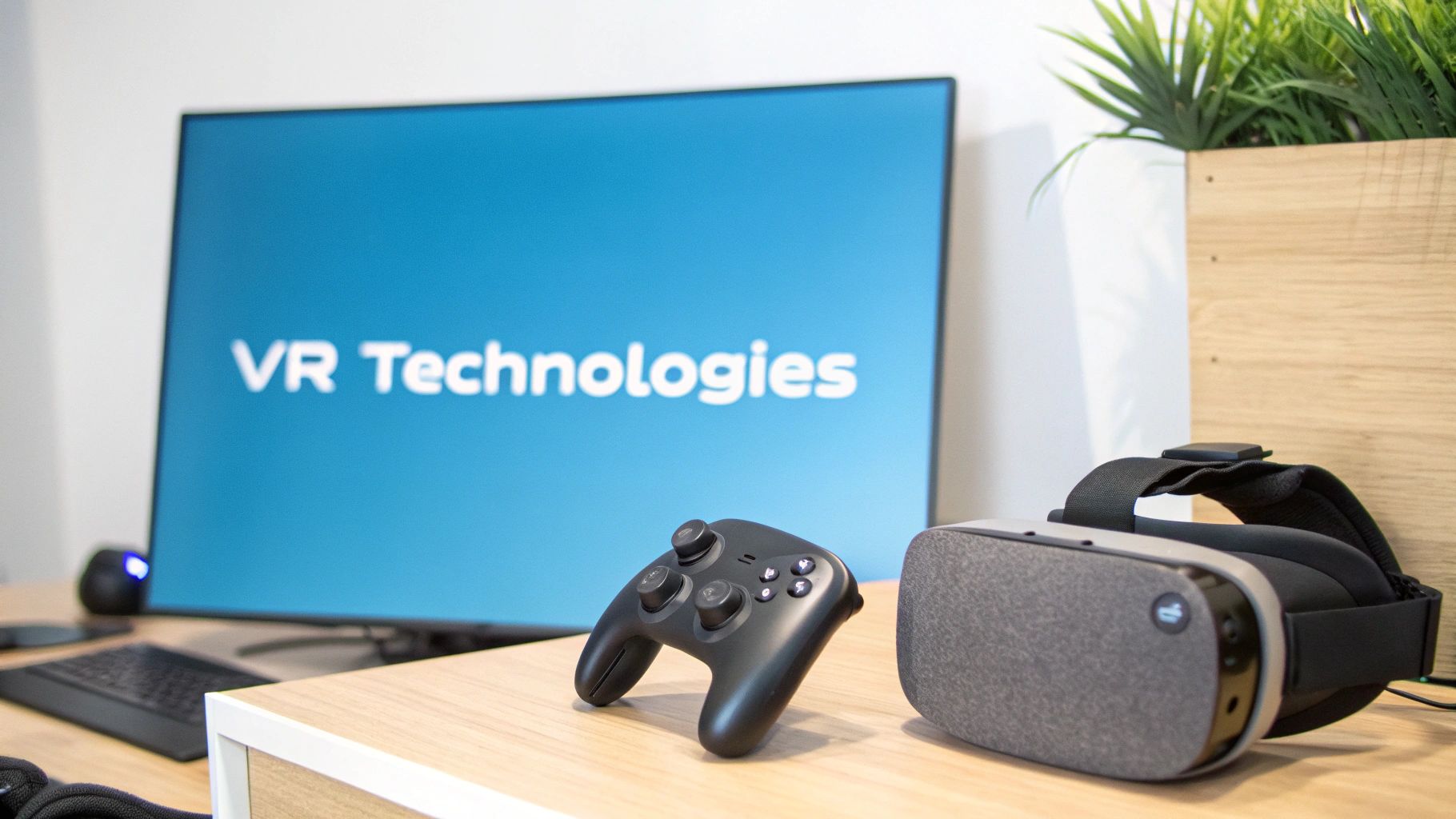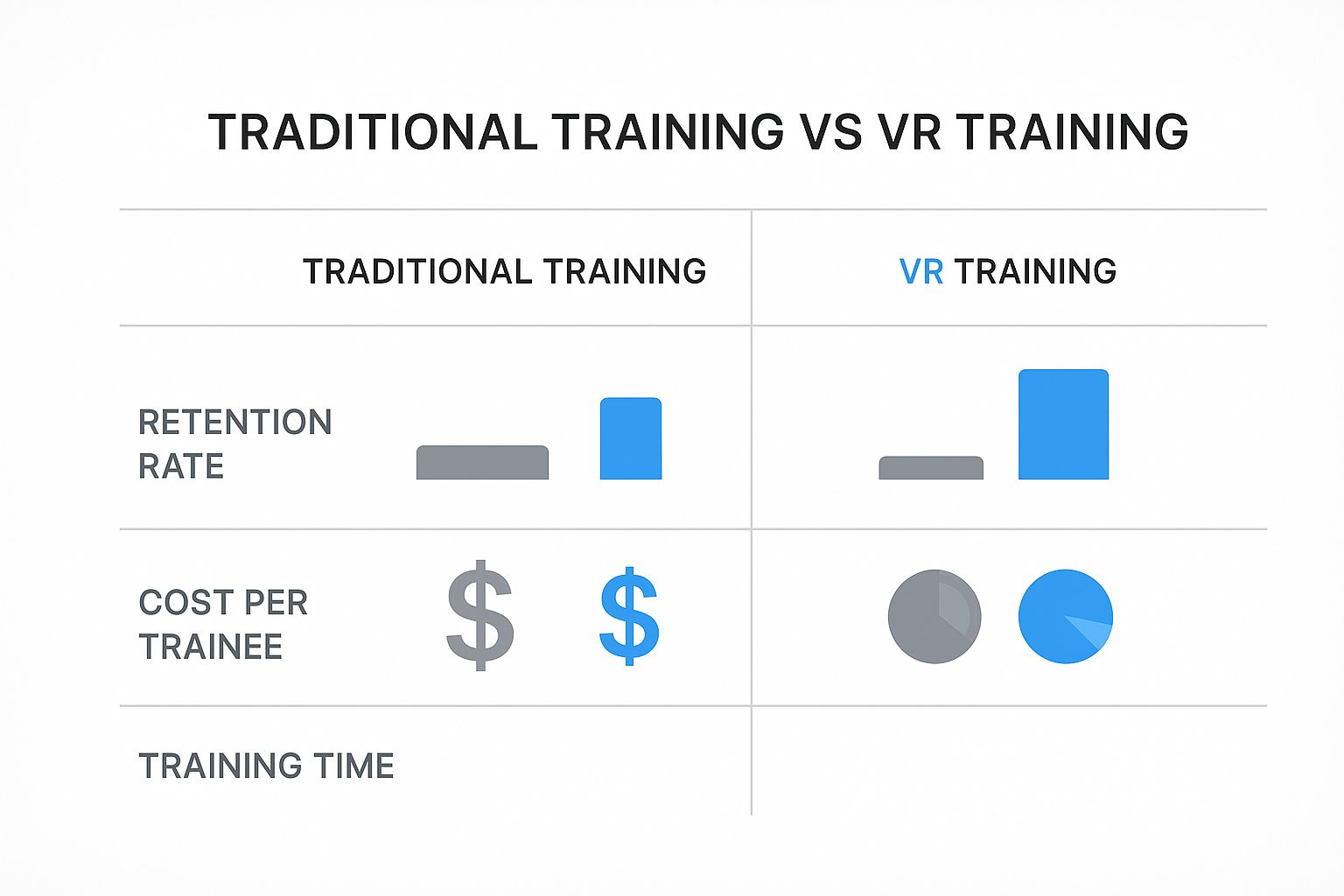What Is Virtual Reality Training? Unlock Its Benefits Today
So, what exactly is virtual reality (VR) training? Think of it as a hands-on workshop in a headset, letting your team practice complex skills in a completely safe, computer-generated 3D world.
Instead of just reading about a critical procedure, they can do it. Over and over again. All without any real-world risk.
Defining the Next Generation of Workforce Development
Virtual reality training is where learning shifts from passive observation to active, hands-on participation. It immerses users so completely in a simulated environment that their brains are tricked into believing the experience is real.
This feeling of "presence" is the key to its effectiveness. It’s what creates deeply memorable lessons that stick with employees and translate directly to how they perform on the job. This isn't a tech novelty; it's a strategic tool for building a more confident, competent, and safer workforce.

This approach is a significant leap forward from traditional methods. By engaging multiple senses at once, VR creates the perfect space for mastering everything from operating heavy machinery to performing delicate medical procedures. It provides a safe sandbox for failure, letting employees practice until they get it right, consequence-free.
To give you a clearer picture, here’s a breakdown of what makes VR training effective.
Virtual Reality Training At a Glance
| Component | Description | Key Benefit |
|---|---|---|
| Immersive Environment | A fully simulated, 360-degree digital world that replicates a real-world setting. | Creates a sense of "presence," making the training feel real and highly memorable. |
| Interactive Scenarios | Hands-on tasks and simulations that require the user to actively participate. | Builds muscle memory and practical skills through active "learning by doing." |
| Real-Time Feedback | Immediate performance data and guidance provided within the simulation. | Allows for instant correction and reinforcement, accelerating the learning curve. |
| Risk-Free Practice | A safe space where mistakes have no real-world consequences. | Boosts confidence by allowing unlimited practice on high-stakes tasks without fear. |
This combination of elements is what makes VR such a powerful and effective tool for modern workforce development.
Why VR Training Is Gaining Momentum
The rapid adoption of VR training is backed by proven results. In 2023, the global VR education market was valued at around $4.4 billion and is on track to hit $28.7 billion by 2030. Studies show VR training can boost learning effectiveness by as much as 76%, leading to better memory and much higher confidence levels.
This growth is fueled by companies looking for more effective ways to train their teams. VR directly solves some of the most persistent training challenges:
- Safety: Employees can practice high-stakes scenarios—like emergency shutdowns or handling hazardous materials—in a 100% risk-free setting.
- Consistency: Every employee gets the exact same high-quality training, every time. No more variations based on location or instructor.
- Scalability: A single VR module can be rolled out to thousands of employees across the globe simultaneously, removing logistical barriers.
- Engagement: The interactive, game-like nature of VR grabs and holds attention far better than traditional presentations.
The Power of Immersive Learning
At its heart, what is virtual reality training if not a powerful form of immersive learning? This approach uses technology to create a sense of deep engagement, making the learning experience feel personal and immediate. By letting people actually do their job functions in a simulation, VR closes the gap between knowing something in theory and being able to do it in practice.
VR training transforms abstract concepts into tangible skills. It's the difference between reading a flight manual and actually sitting in a pilot's cockpit—the experience is fundamentally more impactful and memorable.
Ultimately, VR provides a platform for "learning by doing" on a massive scale. It gives your team the repetitions they need to build muscle memory and the confidence to perform flawlessly when it really counts. As organizations hunt for a competitive edge, VR training is emerging as the clear next step in professional development.
How VR Technology Actually Creates Immersive Learning
To understand why virtual reality training is so powerful, it's useful to look at the technology. The goal of the hardware and software is to work together to create a convincing sense of ‘presence’—that genuine feeling of actually being somewhere else. That feeling is the key to effective immersive learning.

This feeling of immersion is what sets VR apart from other training methods. It’s a carefully orchestrated sensory experience, designed to convince your brain that the virtual world is your current reality. When that happens, learning accelerates and skills stick.
The Core Components of Immersion
Virtual reality is a combination of hardware and software working in sync. Each component has a critical job in building a world that you can not only see and hear, but also interact with in a way that feels real.
Three main elements make it all possible:
- VR Headsets: This is your gateway. The headset uses high-resolution screens and special lenses to serve up a stereoscopic 3D image that completely fills your field of view. It’s what shuts out the real world and pulls you into the digital one.
- Motion Tracking and Controllers: These are the devices that bring your body into the simulation. When you turn your head, walk around, or reach out with your hands, the tracking makes sure your virtual avatar does the exact same thing. It’s what makes every interaction feel natural.
- Spatial Audio: Sound is a massive, and often overlooked, part of the equation. Technologies like spatial audio make sure sounds come from the correct direction and distance, which is absolutely crucial for building that sense of realism and presence.
Bringing the Virtual World to Life
When these components work together, they create a feedback loop that tricks your brain into believing it's truly in the simulated space. A trainee reaches for a virtual tool with a controller, and they see their digital hand move in perfect sync with their physical one. That’s the connection that builds belief.
This technological harmony is why hardware is such a big piece of the immersive training market. By component, hardware makes up the largest revenue share at about 48.2%. It shows how critical these devices are for creating believable experiences. And virtual reality itself? It dominates the technology-driven market with a 46.0% share, cementing its place as the go-to immersive tech for training.
The goal of VR technology isn’t just to show you a different place; it’s to convince your brain that you are in that place. This sense of presence is what unlocks true "learning by doing" in a safe, simulated environment.
From Technology to Tangible Skills
Ultimately, the hardware and software are just tools. The real magic happens when this technology is backed by a powerful digital infrastructure that can handle complex, data-rich simulations. As we cover in our guide, AI-powered XR needs more than just algorithms; it demands a solid foundation to deliver training that is consistent, scalable, and genuinely effective.
By building that convincing bridge between simulation and reality, these technologies allow employees to build real muscle memory and sharpen their critical thinking skills. This is how VR training graduates from simple instruction to become a platform for genuine skill mastery, preparing your team for real-world challenges.
The Business Case for VR Training
While the technology is impressive, for any business leader, the real question comes down to the bottom line. How does implementing virtual reality training deliver tangible, measurable advantages? This is where VR stops being a novelty and starts being a strategic investment, one that pays clear dividends in safety, skill retention, and cost-efficiency.

VR training transforms your training budget from an expense into an engine for operational excellence. It creates a completely controlled world where employees can master their roles without the real-world risks and costs that come with traditional, on-the-job learning.
Improving Safety in High-Stakes Environments
In industries where a single mistake can lead to disaster, safety is paramount. VR training offers a zero-risk sandbox where your team can practice dangerous procedures over and over again until execution is flawless.
For example, an energy company trainee can run through emergency shutdown protocols on a volatile piece of equipment. They can face the scenario, make a mistake, learn from it, and try again—all without any actual danger to themselves, their colleagues, or company assets.
This kind of hands-on practice doesn't just build procedural knowledge. It builds the muscle memory and calm confidence needed to act correctly when the pressure is on, leading to a significant reduction in workplace accidents and a stronger safety culture.
Boosting Knowledge Retention Through Active Learning
We've all experienced the "in one ear, out the other" problem with traditional learning, which is often based on passive observation. VR flips that model by demanding active participation.
When employees are immersed in a simulation, they are doing the job. This hands-on, repeatable practice engages the brain on a much deeper level, causing knowledge retention rates to skyrocket. Research shows that learners in VR can demonstrate up to 76% higher effectiveness compared to traditional methods.
By allowing unlimited, consequence-free repetition of complex tasks, VR training hardwires critical skills into an employee's memory. This closes the common gap between knowing what to do and actually being able to do it flawlessly when it counts.
Achieving Significant and Scalable Cost Savings
While new technology comes with an initial investment, the long-term cost savings from VR training are both significant and multifaceted. Traditional training often accumulates expenses that VR can shrink or eliminate.
A logistics firm, for example, can train new forklift operators without risking damage to the warehouse or goods. An aerospace company can teach complex assembly procedures without using expensive, single-use materials for practice runs.
Here are a few of the biggest areas where businesses see major cost reductions:
- Reduced Travel: Train your global workforce from a central hub without the staggering costs of flights, hotels, and travel allowances.
- Minimized Equipment Downtime: There’s no need to pull critical machinery offline for training, so production lines can keep running without interruption.
- Lower Material Waste: Trainees practice on virtual components, which means you stop paying for physical materials used in practice.
Ensuring Consistent Training Across the Enterprise
One of the toughest challenges for companies with a distributed workforce is making sure every employee gets the same high-quality training. Instructors have different styles, and on-the-job learning can be inconsistent from one site to the next.
VR solves this. It delivers a perfectly standardized experience to every user, every time. An employee in North America gets the exact same instruction, faces the same challenges, and is graded against the same metrics as a colleague in Europe or Asia. This creates a uniform standard of excellence across your entire organization.
This scalability is a game-changer for large companies. A single VR module can be deployed to thousands of employees at once, delivering world-class training at a scale that traditional methods cannot match. For a deeper look at these advantages, feel free to explore the key benefits of virtual reality training in our detailed guide.
VR Training Applications Across Industries
Theory is one thing, but seeing how different industries solve specific, real-world challenges with immersive learning is where the power of VR training really shines. Its versatility means it can be adapted for just about any scenario, from a sterile operating room to a noisy factory floor.
This adaptability has fueled its growth, especially in fields where hands-on skill and safety are everything. In fact, medical and healthcare training now accounts for nearly 30% of all VR usage—a clear sign of the demand for realistic, risk-free simulation. It's no surprise that large companies are leading the charge, making up 67.3% of the investment as they search for training solutions that are both effective and scalable. You can discover more insights about the growing AR and VR training market to see just how quickly this is all moving.
This infographic breaks down the clear advantages of an immersive approach over traditional methods.

The data tells a compelling story. VR doesn't just supercharge knowledge retention; it gets it done in less time and at a lower cost for every person you train.
To get a better sense of this, let's look at how different sectors are putting VR to work. The applications are as diverse as the industries themselves, each one leveraging the technology to solve unique operational hurdles.
VR Training Applications by Industry
| Industry | Primary Use Case | Core Business Impact |
|---|---|---|
| Healthcare | High-risk surgical procedure practice and clinical skills. | Reduces medical errors, accelerates skill acquisition, and improves patient outcomes. |
| Manufacturing | Heavy machinery operation and complex assembly lines. | Minimizes workplace accidents, cuts down on equipment damage, and boosts production speed. |
| Retail | Soft skills and de-escalation for customer interactions. | Enhances customer satisfaction, improves employee confidence, and builds brand loyalty. |
| Construction | Hazard identification and safety protocol adherence. | Lowers incident rates, ensures regulatory compliance, and creates a safer work environment. |
These are just a few examples, but they illustrate a common theme: VR creates a space for people to learn by doing, which is always more powerful than learning by just listening.
Healthcare and Medical Training
Nowhere are the stakes higher than in healthcare, and it’s here that VR is truly making its mark. Medical professionals can step into a virtual operating room to practice a complex surgery, repeating it dozens of times before ever touching a patient. It’s about building both skill and confidence in a completely safe environment.
Nursing students, for example, use VR to learn essential skills like inserting a catheter or placing an IV. They can even interact with AI-driven virtual patients to practice navigating difficult conversations.
Virtual reality gives medical trainees unlimited attempts to perfect high-risk procedures without jeopardizing patient safety. This consequence-free practice is invaluable for building the muscle memory and decision-making abilities needed in critical moments.
This kind of simulated, hands-on experience prepares them for the pressures of a real clinic in a way a textbook never could. To see more on this, you can learn how organizations are using virtual reality for medical training to redefine medical education.
Manufacturing and Industrial Operations
On the factory floor, VR training is a game-changer for both safety and efficiency. A new hire can learn to operate complex machinery in a simulation, completely removing the risk of costly equipment damage or personal injury.
Think about a technician learning a multi-step assembly process. In VR, they can:
- Visualize the Entire Process: See a complete, step-by-step digital guide of the assembly before they even start.
- Practice Hands-On: Virtually pick up tools and parts to build the product, getting instant feedback and corrections.
- Simulate Fault Scenarios: Practice troubleshooting common malfunctions in a controlled space, so they’re ready for real-world issues.
This approach dramatically shortens the learning curve. It ensures people are fully competent before they hit the production line, cutting down on errors and boosting productivity from day one.
Retail and Customer Service
VR’s reach extends far beyond industrial settings. Retail companies are now using it to sharpen soft skills, especially in customer service. Associates can practice handling tough customer interactions, de-escalating conflicts, and managing stressful situations.
These simulations drop employees into realistic scenarios with virtual customers who might be angry, confused, or upset. It’s a safe space to test out different communication strategies and get immediate feedback, helping them build the confidence and empathy needed to deliver great service.
Construction and Hazardous Environments
The construction industry relies on VR to get workers ready for dangerous environments. Before ever setting foot on a job site, teams can run virtual safety walkthroughs to spot potential hazards, practice emergency evacuations, or learn how to work safely at heights.
For instance, a simulation might challenge a worker to inspect a virtual scaffold for safety violations or correctly use fall protection gear. This proactive approach to safety training makes a real difference, significantly reducing the likelihood of on-site accidents and creating a safer environment for everyone involved.
How to Implement a VR Training Program
Rolling out a virtual reality training program is a strategic process, but it’s far more manageable than most leaders think. Getting it right involves a clear, phased approach that builds momentum and proves its value every step of the way.
The process starts with a simple, powerful question: what business problem are we trying to solve?
Identify a High-Impact Use Case
Before you think about headsets or software, the first step is to pinpoint a critical business challenge where VR training can make a real, measurable difference. Instead of attempting a broad implementation, find one specific, high-impact problem to build your proof of concept around.
A great place to start is by looking for training scenarios that are high-risk, high-cost, or logistically difficult.
Consider situations like these:
- Safety-Critical Tasks: Are there procedures where one mistake could cause injury or damage expensive equipment? Simulating things like emergency shutdowns or handling hazardous materials is a perfect job for VR.
- Complex Manual Processes: Do your teams perform intricate, multi-step assembly or maintenance tasks? VR is excellent for building the muscle memory needed for these jobs.
- Rare but Crucial Events: How do you effectively train for something that almost never happens but is catastrophic when it does? VR lets you practice for those high-stakes moments whenever you need to.
By zeroing in on a specific pain point, you create a clear metric for success. This makes it much easier to show tangible results to stakeholders.
Select the Right Technology Partner
Once you know what you want to fix, you need to find a partner who can help you build the solution. This is about more than just buying hardware. You're looking for a team that has deep expertise in both immersive technology and the specific challenges your industry faces.
Your ideal partner should be a guide, walking you through everything from choosing the right hardware to developing the content and integrating it into your existing systems. They need to understand your operational goals and shape a solution that fits, whether that’s a flexible SaaS model or an on-premise deployment.
A great VR program is built on collaboration. Your technology partner should feel like an extension of your own team—the technical experts who can turn your business goals into an engaging and effective virtual training experience.
Develop and Launch a Pilot Program
With your partner and plan in place, it’s time to build the training content and kick off a pilot program. This is your chance to test everything, gather feedback, and fine-tune the experience before a full-scale rollout. A pilot lets you validate your approach with a small, manageable group of employees.
This phase breaks down into a few key activities:
- Content Creation: You'll work closely with your partner to build a simulation that replicates the real-world task. The goal is to create an experience that meets your specific learning objectives.
- Deployment and Onboarding: Get the technology into the hands of your pilot group. This means clear instructions and solid support to make sure everyone is comfortable and confident with the headset and software.
- Feedback Collection: Actively ask for feedback from your trainees. What worked? What was confusing? Their insights are invaluable and will tell you exactly what needs adjusting.
Measure Your Return on Investment
Finally, to make the case for a broader rollout, you have to prove it works. That means establishing clear metrics to measure the success of your pilot. The data you collect here is the foundation of your business case for expanding VR training across the organization.
Your key performance indicators (KPIs) should tie directly back to the problem you first identified.
- Performance Metrics: Track things like skill acquisition, time to complete tasks, and error rates inside the simulation. Are people learning faster and making fewer mistakes?
- Business Impact: Measure what changes in the real world. This could be a drop in workplace accidents, less equipment downtime, or getting new hires up to speed faster.
- User Feedback: Check in on employee engagement and satisfaction. Do they feel more confident and better prepared to do their jobs after using the VR training?
A successful pilot proves the value of what is virtual reality training in a concrete, measurable way. It gives you the evidence you need to expand the program and drive real, lasting improvements across the entire organization.
The Future of Workforce Development Is Already Here
Virtual reality training is not a far-off concept. It's a practical tool that companies are using right now to gain a competitive advantage. The message is simple—immersive learning delivers better results in safety, efficiency, and mastering complex skills. This technology closes the gap between knowing something in theory and being able to do it in the real world.
The companies adopting VR now are building the highly skilled teams they will need for the future. This is more than just a new training module; it's a complete shift away from passive learning toward dynamic experiences that deliver tangible results.
What's Next for Immersive Learning
The technology behind VR training is constantly improving, becoming more powerful, and easier to use. To understand where this is going, it helps to see VR as part of the bigger picture of emerging tech trends in education, which all point toward more personalized, data-backed learning.
A few key developments are pushing the envelope:
- AI-Driven Scenarios: We're seeing more artificial intelligence integrated into training to create adaptive learning. These smart simulations can change the difficulty based on a user's performance, serving up personalized challenges that help them learn faster.
- Biometric Feedback: Systems will increasingly use biometric sensors to track a trainee's focus, stress levels, and engagement. This data gives trainers incredible insight, letting them see exactly where an employee is succeeding or struggling.
- Enhanced Haptics: The technology behind haptic feedback—such as gloves that let you feel the texture and resistance of virtual objects—is becoming more sophisticated. This will make virtual tasks feel astonishingly real, locking in muscle memory for hands-on work.
The organizations that adopt immersive technology today are not just updating their training manuals; they are fundamentally rethinking how skills are built. They will be the ones best equipped to lead their industries tomorrow.
This is your chance to move beyond outdated methods and invest in a system that prepares your team for today's challenges and tomorrow's opportunities. The time to lead this change is now.
Common Questions About VR Training
When business leaders evaluate new technology, practical questions come up first. Understanding what virtual reality training really is means getting past the hype and focusing on what it actually means for your team and your budget. This section tackles the most common questions we hear from organizations considering immersive learning.
Our goal here is to give you clear, straight answers to help you make an informed decision. We'll cover everything from the hardware you'll need to the kind of return you can expect.
How Much Does VR Training Cost?
This is always the first question, and for good reason. While there's an upfront investment in headsets and content creation, the long-term ROI is where VR starts to make sense. The final cost depends on the complexity of the simulation and the number of users, but many companies find that VR is more cost-effective than their previous training methods.
Consider the costs it starts to erase:
- Travel and Hotels: No more flying teams out to a central training facility.
- Wasted Materials: Trainees can practice on virtual parts without using expensive physical inventory.
- Equipment Downtime: Your critical machinery can keep running while employees get up to speed in a perfect digital twin.
The initial investment in a VR training program is often quickly offset by significant reductions in ongoing operational costs, turning a perceived expense into a measurable source of savings and efficiency.
What Kind of Hardware Is Needed?
Getting started with VR is simpler than most people imagine. The main piece of equipment is a standalone VR headset—a single, wireless device with all the processing power, screens, and sensors built right in. Today's headsets are user-friendly and don’t need to be tethered to a high-powered computer.
For most training scenarios, the standard hand controllers that come with the headset are all that is needed for trainees to interact with the virtual world. The goal is to use accessible, scalable technology that you can roll out to your workforce without a massive IT project. That simplicity makes VR a practical tool for almost any business.
How Long Does It Take to See Results?
The impact of VR training often shows up almost immediately. Employees learn complex skills faster and retain what they’ve learned for much longer. One study of nursing students found that 92% felt virtual patient scenarios made them better prepared for real-world clinical work, showing an near-instant boost in both confidence and skill.
As for bottom-line business results—like fewer workplace accidents or better production numbers—a measurable impact can usually be seen within the first few months of launching a program. The key is to start with a focused pilot that targets a specific, high-value business problem. That's the fastest way to prove its worth.
Ready to see how immersive training can transform your workforce? The team at AIDAR Solutions specializes in creating powerful VR and AR applications that deliver measurable results, from accelerating employee skills to improving operational efficiency. Explore our solutions today.


